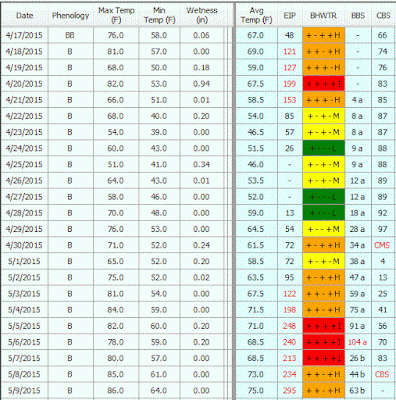CAUTION: The observations, conditions, and recommendations
reported for Winchester, VA are provided as a guide to fire blight risk
assessment only for the immediate area of the Virginia Tech AREC located six
miles southwest of Winchester. Use of the information reported here for making
orchard management decisions outside of that area is not our intent. Fruit
producers outside of that area are encouraged to consult their state extension
specialists for information similar to that provided here.

FIRE BLIGHT: Above is a cropped graphic from the Maryblyt 7
program. All cultivars are now in bloom and most of them are near full bloom. Here is
the prediction for trees with first bloom open last Friday or Saturday, April
17-18, 2015. The temperature and rainfall data are current through Thursday morning,
April 23. Predicted weather conditions are shown for April 23-27. The
components of fire blight risk are indicated in the columns labeled B (blossoms
open), H (degree hours for epiphytic bacterial populations), W (wetting by rain
or dew), and T (average daily temperature 60 F or above). Based on recorded
temperatures and wetting, the risk column shows that fire blight infection was
possible Apr 20 and would have been possible with slightly warmer average
temperatures for Apr 19 and 21. For infection to be predicted, wetting must
occur after the EIP (epiphytic infection potential) reaches 100 or higher. Infection for Apr 19-21 would have been more
likely in areas where bloom is more advanced, and temperatures warmer than those
shown, and if wetting also occurred Apr 19 and 21. In high-risk situations, a
protective streptomycin application is recommended ahead of predicted
infection. Based on predicted temperatures, risk should now remain low to
moderate through Apr 27 (and well into next week).
The CBS
column at the right in the graphic indicates progression toward the appearance
of canker margin symptoms on new growth, due to extension of overwintering
cankers from last year, 89% of the degree hour requirement by Apr 27. Canker
advancement cannot be prevented by chemical treatment at this time and the
presence of symptoms will indicate a build-up of inoculum which could become a
factor in the event of a trauma blight situation due to hail injury, etc. The
BBS column is tracking predicted appearance of blossom blight symptoms from
infection Apr 20, now with only 12% of the degree hour requirement for
predicted symptom appearance, which will be much delayed with cooler weather into
next week.
The weather conditions used in the predictive part of this
graphic come from the Weather Channel for Winchester, supplemented by
site-specific data from SkyBit Inc. Be aware that risk can change quickly with
unpredicted warmer temperatures and wetting.













